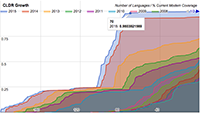
Unicode CLDR 28 provides an update to the key building blocks for software
supporting the world's languages. This data is used by all
major software
systems for their software internationalization and localization, adapting
software to the conventions of different languages for such common software
tasks. The following summarizes the main improvements in the release.
- General locale data. Overall, about 5% of the data items in this
release are new (see Growth),
while about 8% have corrections. Notable changes include a major review of
and improvement to Spanish locales for Latin America; the addition of two
new “modern-coverage” locales (Belarusian and Irish); and moving certain
data from en_GB to en_001 for improved quality and reduced data size in
locales that use en_GB conventions.
- Formatting. There are a number of new units and types of formats,
with a major revision to the
day period rules—preferred for many languages instead of AM/PM (“10:30
at night”)—with localizations; the addition of compact formatting for
currencies (“€10M”, “€10 million”), and the addition of more unit measures,
including 7 new general units (duration-century), 21 new per-unit types, 4
new units for measuring personal age (needed for some languages), and new
coordinate units for formatting latitude and longitude across languages
(“10°N”).
- Identifiers. The new features extend the ability to specify
subregions of countries, validate identifiers, and customize locales,
including the addition of subdivisions of countries, such as Scotland
and California (localized names are not yet present, except for
English); the addition of
validity data for currency codes, measurement units, and locale
identifier elements (allowing validation of Unicode language and locale
identifiers without requiring BCP47 data); the addition of seven -u-
extension keys and corresponding types to allow customization of locales
(“cf” for specifying standard vs accounting currency formats),
and the clarification of the specification of identifiers, especially for
validity testing.
The
specification and
charts have
also been updated.
 Unicode CLDR 28 provides an update to the key building blocks for software
supporting the world's languages. This data is used by all
major software
systems for their software internationalization and localization, adapting
software to the conventions of different languages for such common software
tasks. The following summarizes the main improvements in the release.
Unicode CLDR 28 provides an update to the key building blocks for software
supporting the world's languages. This data is used by all
major software
systems for their software internationalization and localization, adapting
software to the conventions of different languages for such common software
tasks. The following summarizes the main improvements in the release.


